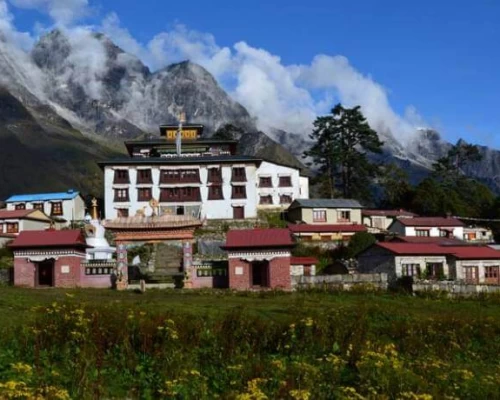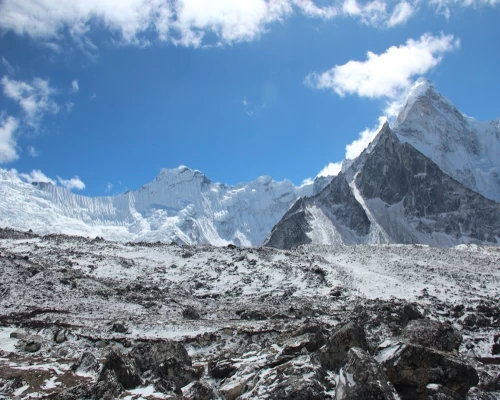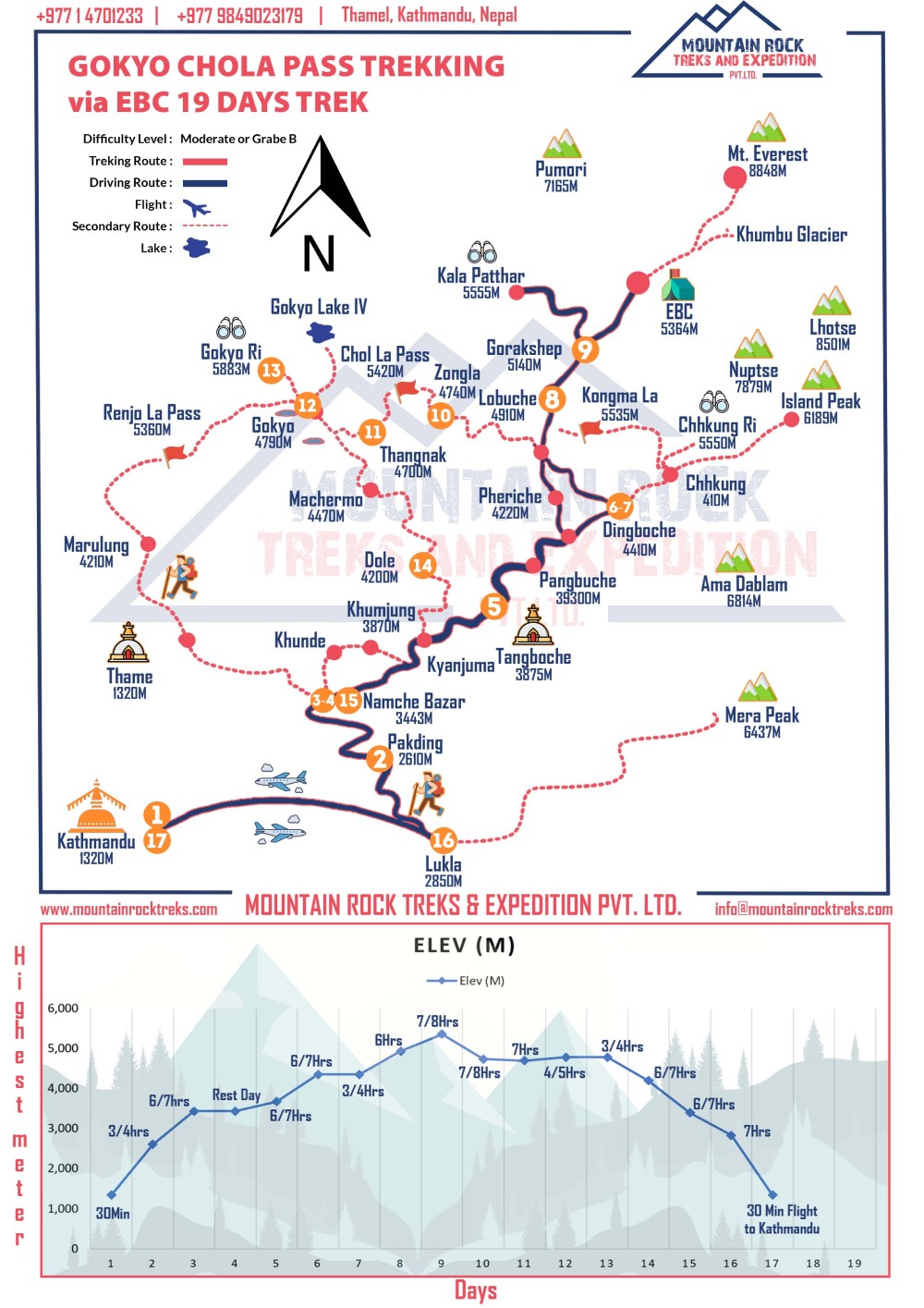Gokyo Chola Pass Trekking amidst a world teeming with tourism opportunities, Nepal stands as a haven for adventurers seeking high-altitude trekking experiences. This awe-inspiring mountainous nation boasts captivating peaks, rolling hills, serene basins, picturesque valleys, and vast dun areas, captivating travellers from every corner of the globe.
Located within its terrain are the world's tallest mountain range, Mount Everest, and numerous other peaks rising above 8000 metres. While trekking has long been a favoured activity in this country, the appeal of personalised hiking options has drawn an even larger crowd. In this regard, we present a genuinely unique trekking journey: the Everest Base Camp Cho La Pass Gokyo Trek.
The Gokyo Cho La Pass Everest Base Camp Trek offers a more thrilling experience than other treks in the region. With this in mind, the trek covers the usual highlights like Namche Bazaar, Tengboche Monastery, Gorak Shep, and Everest Base Camp. But what sets the trek apart from the regular Everest base camp trek is the journey to Gokyo Lakes through the challenging Cho La Pass (5,330m) at a high altitude.
Though some days demand 8 to 9 hours of trekking, most are about 5 to 6 hours long. This adventure is perfect for those with endurance and a spirit of exploration. Arriving and exiting from Lukla allows for maximum time amidst the mountains. However, acclimatisation is essential, which takes place in the renowned Namche Bazaar. From there, you can take a short yet steep walk to Syangboche for an up-close view of Mount Everest, Lhotse, Ama Dablam, and Thamserku.
Combining the Everest base camp, Gokyo valley, and the high Chola pass at 5420m elevation, this trail blesses stunning views of Himalayan giants: Everest (8,848 m.), Lhotse, Makalu, Amadablam, Kanchenjunga, Nuptse, Pumori, and more. Nature's beauty, Sherpa culture, lush forests, snowy paths, and the high pass create an unforgettable experience.
Gokyo Valley, a remote Himalayan gem, reveals mountains, glaciers, and the enchanting Gokyo Lake. Likewise, the cultural highlights from festivals like the Dumji festival delight in April, the Mani Rimdu festival Sherpas and the Dance in their monasteries are very memorable. This trek offers mountain vistas, the Sacred Lakes of Gokyo, river valleys, glaciers, and the Chola pass crossing—a true heavenly pleasure.
Most likely, this is the only trail every hiker aspires to complete once in a lifetime. You should be well-prepared and adequately acclimatised to finish this challenging journey. You can view Mount Everest and three other summits from the highest mountains in the world, Lhotse, Makalu, and Cho Oyu. Moreover, you will never forget the feeling of being so near to such magnificent mountains that sparkle with holiness and spirituality. You will explore the lesser-known regions underneath Everest, such as the inaccessible Gokyo Valley with its celebration of stunning blue lakes and lunar-like glaciers.
EBC Chola Pass Gokyo trek begins with a scenic journey from Kathmandu to Lukla. You begin your trip from Lukla by going down the valley of the Dudh Koshi River. Rhododendron and pine forests, the Dudh Kosi valley, Sagarmatha National Park, high passes, waterfalls, and picturesque Sherpa settlements like Phakding, Namche Bazaar, Tengboche, Lobuche, and Pheriche are all sights you travel through. Likewise, the UNESCO-designated Sagarmatha National Park is home to various plants, animals, and birds, including the snow leopard, red panda, and Himalayan Thar. The Sherpa people's welcoming demeanour and kind greeting only enhance the guests' enjoyment. In this journey, you also go to Kala Pattar, the perfect vantage point to see Mount Everest and other peaks in the distance.
Although this journey has its difficulties, such as lengthy and exhausting walking days, the rewards—personal accomplishment and a one-of-a-kind picture album are great. Therefore, if you believe this trekking is for you, then Mountain Rock Treks will introduce our carefully organised EBC Chola Pass Gokyo Lake trek itinerary, providing an unforgettable experience. Bookings for 2025 and 2026 are currently open.
Note:- If you think of an alternate option for This Trek you might consider our Everest base camp trek return by helicopter. If you are short of holiday for ten days, you can get 5 hours Everest base camp helicopter tour. If you are here for an anniversary trip, honeymoon trip, or Engagement trip, you can choose the Luxury Lodge Everest base camp trek. Or if you scare with flight you can do the Everest base camp trek by land too. Probably, this will be a tweetable alternative trip for you.
Gokyo Chola Pass Trek Highlights
- 360 degrees Views of Mount Everest, Lhotse, Nuptse, Ama Dablam, Island Peak, and many more stunning Himalayan peaks are available.
- Reach a height of 5,420 meters above sea level at Cho La Pass.
- Discover the Gokyo Valley's Five Lakes series, which offers breathtaking landscapes and crystal-clear water.
- Gokyo Ri Peak climb.
- Immerse yourself in the Sherpa culture of the area.
- Visit Tengboche Monastery to learn more about local Buddhism.
- Arrive at Everest Base Camp and take in the scenery.
- At 5,644 meters, Kala Patthar offers 360-degree views of the Himalayas, sunrises, and sunsets.
Benefits of Booking Everest base camp chola pass Gokyo trek With Us
Trekking with a local trekking company and local guides is crucial for hikers as it has several advantages. Local hiking companies provide you with knowledgeable local guides at reasonable rates. Likewise, these guides are born and raised in that place, so they are well aware of both the advantages and disadvantages of the journey.
The following bullet points discuss some of the trekkers' main benefits and why they should go with us.
- Free International Airport Pickup and Drop off facilities:- The first question a traveller could have is, "What next" after they arrive? Many tourists may be visiting Nepal for the first time on this trip. Everything will be different for a newbie travelling to this region, including the rules, regulations, culture, and people. We are here to assist you with a private car, van, jeep, or bus service and free information on travel destinations in Nepal if you want to avoid getting perplexed and wondering how to get further to your destination after arrival for your Everest base camp chola pass Gokyo trek.
- Offer high-quality amenities:- We employ local guides knowledgeable enough about where to get a very friendly and reasonably priced place to stay, food, camping equipment, and other amenities. They can negotiate a fantastic bargain regarding lodging or meals because they are well-versed in the local market. They know about the region's well-known and distinctive local cuisine, lodging options, and shopping locales.
- Map of Everest Region:- Additionally, we provide trekkers with a map of every zone for hiking. You will receive a graphical representation of the data on the map, including common sets of icons and symbols with various shapes and colours. The map also shows elements like the International Boundary, the National Park Boundary, the Highway, the Main Road, the Main Trekking Route, the Secondary Trekking Route, the Peaks, the Temple, the Monastery, the Chorten, the Airport, the Helipad, the Glacier, the Rivers, the Check Point, and many more.
- Knowledge of the Route:- It goes without saying that one of the most important factors is that the local trekking guides are knowledgeable about the hiking path. They are totally knowledgeable about the walk's location, surrounding factors, advantages and disadvantages, degrees of difficulty, climate, weather, etc. As a result, you may simply get support from us in an emergency. As we all know, the Himalayan area has a long history of erratic weather. This occasionally puts the passionate hiker in some uncomfortable situations. Our local guide can readily help them in such a situation by offering the necessary support.
Is the Everest base camp chola pass Gokyo trek Suitable for You?
- Our Everest Chola Pass Trek with Gokyo Lakes and the Base Camp is a 15-day trip package for adventure seekers who enjoy climbing mountains in Nepal's Khumbu area. The itinerary may be extended or shortened according to your interests and preferences.
- Most of the well-known attractions in the Everest region, including Tengboche Monastery, Namche Bazaar, Gorakshep, Lukla, Everest Base Camp, Gokyo Lakes, and crossing Chola Pass (5,420 metres, 17,782 feet), are included in the all-inclusive itinerary.
- With its alluring splendour of mountains, glaciers, valleys, mountain passes, mountain lakes, and more, the trek makes you yearn to travel.
- For experienced and enthusiastic high-altitude hikers, this trip package to Everest Base Camp with Gokyo Lakes through the Chola Pass is excellent.
- The number of magnificent locations you will see while on the Gokyo, EBC, and Chola Pass Treks is endless. You'll hike to a well-known high pass on Everest and create unbroken memories while doing the High Chola pass.
- First, this hike takes you to the base camp of the tallest peak in the world. Every travel enthusiast's top wish is likely to be to experience it.
- The journey then leads you to lovely places like Gokyo Valley. From here, you may take in the splendour of serene, emerald-green alpine lakes exquisitely carved out of the snow-covered rocky terrain.
- Although we encourage you to reserve your treks and adventures in advance, we also accept last-minute reservations.
- Accommodations for 15 nights are included in this trek package in the trek area. We hand-pick only the finest lodges for you to stay at.
- Due to the high altitude and closeness to the tallest mountains in the world, the Everest Base Camp with Chola Pass Gokyo Trek journey necessitates the consumption of sanitary, nutrient-rich meals. While we will provide you with enough wholesome food, your selections may become more limited as you trek higher. We'll provide you with 15 breakfasts, 15 lunches, and 15 dinners throughout the journey.
Preparation for Everest base camp chola pass Gokyo trek
Trekking is generally considered an exciting activity, but it may be challenging depending on the terrain, altitude, and weather. Compared to more difficult treks, moderate treks require less planning and preparation.
As a result, those who travel to Everest Base Camp Chola Pass Gokyo Trek don't need to make several preparations. Knowing a bit about the trek's destination will be sufficient and helpful. You'll get a quick overview of the paths and the preparation needed to trek the different terrains.
Know About Difficulty Level
Everest base camp Chola pass Gokyo trek Is moderate to strenuously challenging for someone with good to average fitness. With a day or two off for acclimation, you walk 4 to 6 hours daily for 15 days. You should be able to carry your backpack if you are moderately fit. Still, the hiking journey is made simpler by using porters.
Moreover, there is no need for technical climbing expertise. Regardless of your fitness level, ascending too quickly might cause altitude sickness. The trek route includes several ascents to higher altitudes that are rather difficult.
Physical Preparation
It's difficult to hike through Khumbu's rough highlands at Everest Base Camp (5,364 metres), Kala Patthar (5545m), Cho La Pass (5420m), and Gokyo Peak (5420m).
It has huge obstacles and is quite challenging and intensive. To hike the routes of Everest Base Camp Cho La Pass and Gokyo, one needs to train and exercise. Maintaining your fitness levels is necessary both before and during the hike. You'll evaluate your physical state and create an appropriate workout routine. Instead of pushing yourself over your limitations, take your time and complete each step of the program one at a time. Cardiovascular exercise will help you become more tenacious.
You can maintain the pace even on the lengthy path by running or fast walking. Give yourself time to acclimate if you're a newbie moving from a lower height. Rest before ascending to a greater altitude since straining the body can harm your health.
Mental Preparation
It might be mentally demanding to hike both Gokyo Ri and Everest Base Camp simultaneously. It needs excellent determination and willpower to meet the obstacles and prevail over them. Trekkers must therefore possess mental grit and toughness to endure the arduous day of hiking.
You need to plan and come equipped for the hike. Additionally, be conscious of the difficulties you'll face along the route to avoid losing concentration and being overly anxious. Not to mention, being in shape before the walk can help you overcome the challenging portions of the route.
Important Equipment
The most essential item a hiker needs is trekking gear. The hike would be pretty difficult and exhausting if you don't bring enough necessities. Despite the unfavorable weather and temperature, they are meant to make your journey simpler and more convenient.
The gear for the expedition, however, must be carefully chosen. It is not worth bringing useless or extraneous goods on a hike because they will make your bag heavier. Even though weather circumstances have the most impact on the hiking gear you need for Everest Base Camp, there are several items you just must take.
- Waterproof jackets
- Short and long sleeve shirts
- Moisture-wicking shirts
- Light sweatpants
- Sturdy hiking boots
- Fleece or wool trousers
- Footwear
- Personal toiletries
- Woolen socks
- First-aid kits and medicine
- Insect repellent
- Water bottles and purification
- Sunglasses and sunscreen
- Sun-shielding hats
- Other items
More details of the Packing list in the high Himalayas
Everest base camp chola pass Gokyo trek Cost
Local companies charge around US $ 1500 and US $ 2000 for the EBC Chola Pass Gokyo Valley trek package. It goes without saying that the cost of the EBC Chola Pass Gokyo Valley trek will vary depending on the number of people going with you and the service/accommodation options you select. With this being said, it pays for your lodging, guide/porter, transportation, permit, and airline costs.
You may enjoy your hikes more with a personalized hiking trip. A customized vacation to meet your needs will be perfect if you value flexibility, customization, and in-depth experiences.
Moreover the cost changes with the services you would like to add. If you would like to add a Helicopter flight to and from Lukla, then the package price will cost you a few dollars more.
Generally, your trip cost includes standard accommodation in Kathmandu and Kathmandu, including breakfast, basic tea house accommodations during the Trek, three times meals during the Trek, and a Professional English Speaking Trekking guide. We also offer group prices for the Everest base camp chola pass Gokyo trek.











